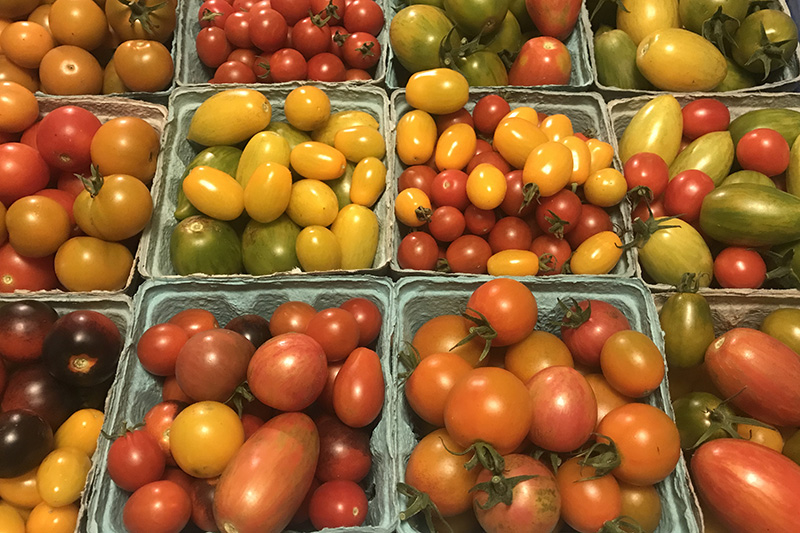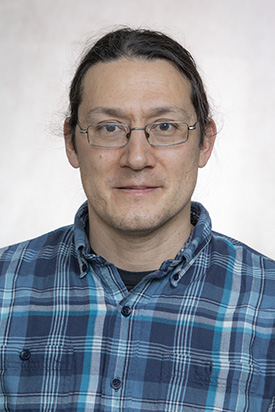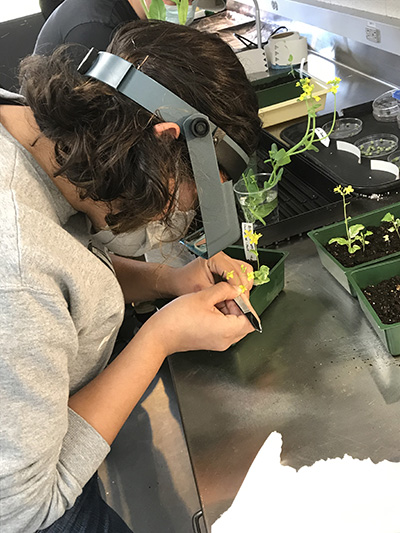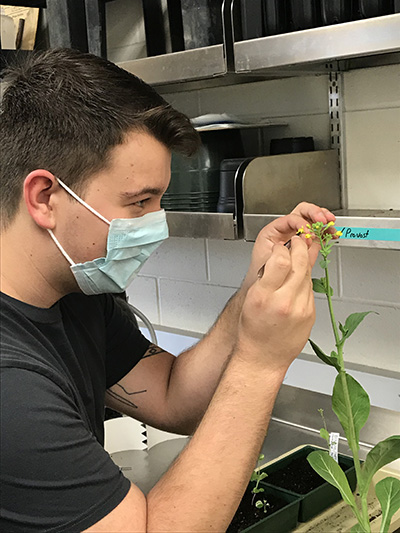- Apply
- Visit
- Request Info
- Give
Connolly receives NASA space grant to breed micro tomatoes
Written by Dwight Bachman
Published on July 16, 2021

Tomatoes grown at Cobblestone Farm in Mansfield by Connolly and his wife Diane Dorfer. Tomatoes with diverse colors, patterns and flavors will be hybridized with micro tomatoes to create a diverse array of small tomatoes that one day may be grown in space.
Billionaire Richard Branson was only up in space for an hour on July 11, but his trip to the edge of space — experiencing weightlessness and returning to earth — is a landmark moment for public space adventures. Future trips will require humans on longer missions to adapt and sustain their health by growing their own food, primarily plants, which provide food, water and oxygen, and appear to be the best way to support the health of people on such space missions. Eastern Connecticut State University Biology Professor Bryan Connolly hopes to make his own contribution to the effort.
Connolly is using funding from the NASA Connecticut Space Grant Consortium to conduct a research project called “Building an Open Source Micro Tomato Breeding Collaborative for Space and Off-Planet Colonies.” The grant is aligned with NASA’s Mission Directorate: Human Exploration and Operations (HEO) and runs to the end of this year.

Connolly, who co-authored the book “Breeding Organic Vegetables: A Step-by-Step Guide for Growers” in 2011, says standard field tomato plants, which grow up to seven feet long, are too large to be cultivated in space. On the other hand, “micro tomatoes” — with plants no more than a foot tall — are ideal for growing in the confined habitats of space. NASA likes tomatoes because they are packed with nutrients essential to the human diet, high in vitamin A, C and K, and a good source of vitamin B9, potassium and antioxidants.
“I propose to create diverse gene pools of small-statured tomatoes by hybridizing micro-tomatoes with other tomato types that vary in color, flavor and shape,” said Connolly. “These gene pools will be shared with universities, schools, and amateurs to develop a network of breeders to select new micro tomatoes for space.”
He said a collective informal worldwide network, called the Dwarf Tomato Breeding Project, has already been established to create new tomato plants that are two- to four-feet tall. “We would like to utilize these dwarf varieties and hybridize them with the even smaller micro tomatoes that are only one foot tall. Once the hybridizations are done, we will grow the first- and second-generation plants and collect the seeds, which will display gene segregation and not breed true for about six generations.”
Connolly says the generation time for the tomatoes is about 90 days, with four generations each year. He hopes to share these seeds with other Connecticut Space Grant affiliates and collaborate with others who can further refine the tomatoes, growing them until the lines with the desired traits are consistent from generation to generation.
Connolly said he wants these seeds to be open source so that anyone can create new tomatoes for space. “Hopefully, an array of micro tomatoes will emerge from this informal network. The newly diverse tomato varieties can be tested in space to see which lines perform the best. These varieties of micro tomatoes can serve as the raw material for more plant breeding or genetic modification in the future.”

In addition to creating small tomatoes for space, Connolly wants Eastern students to learn about plant breeding, plant genetics and the challenges of growing plants in space. “The new tomatoes could also be grown on Earth, where cultivation area is limited such as urban settings and indoor grow spaces. Micro tomatoes have potential as a good general educational tool and would be suited to a classroom or lab setting and could serve as a model organism for conducting research and experiments.”
Eastern students love the hands-on approach to learning plant biology. Maria Rodriguez-Hernandez ’20, currently pursuing graduate studies at Western Connecticut State University, was president of Eastern’s Biology Club and used the greenhouse for growing plants for the club’s annual plant sale.
“I loved working in the greenhouse, it had everything I needed to grow my plants. Dr. Connolly would make sure I had enough space. Jacob, the student worker, would help me a lot, too, finding all the materials I needed. What I enjoyed the most was seeing all the different plants in each room. There was a good variety of different plant species. Being able to work in the greenhouse made me realize how much I love working with plants, which I’m hoping to continue to study in my graduate program.”

For Jacob Paciotti ’21, who is starting graduate school this fall at Stony Brook University in its Ph.D. program in Ecology and Evolutionary Biology, said working as Connolly’s greenhouse assistant for the past two years was an exhilarating experience.
“It introduced me to multiple different disciplines, including horticulture, agriculture and botany, all of which have helped to strengthen and broaden my knowledge of plant science and biology as a whole,” said Paciotti. “As a student in the Biology program, my time in the greenhouse was spent conducting research, learning horticulture techniques, and learning new things about the plants that we rely on and, in many cases, take for granted.”
Connolly says he and his students will obtain seed of six to eight micro tomato varieties including “Micro Tina,” “Micro Tom” and “Micro Gemma,” which are 12” or below in height, along with seeds of 30 varieties representing a large diversity of dwarf tomatoes. These plants will be grown in the Eastern greenhouse, using space-saving, vertical gardening techniques, such as using wall surfaces and hangers to simulate the space limitations on an off-planet colony.
“We will also grow some tomato lines hydroponically under lights in the plant physiology lab, since hydroponic cultivation is likely to happen during space exploration. Once in flower, the tomatoes will be cross pollinated by me and Eastern undergraduates.”
Once the entire pollination process has been completed, Connolly will contact botany and plant science professors at Connecticut Space Grant affiliate universities and high school teachers throughout Connecticut and offer them these segregating dwarf lines to select into their own varieties.
One day, Connolly hopes he and his students will have their plant research as a payload on board a NASA space shuttle ride to the International Space Station, as fresh food for people who have been in space for extended periods of time and have only been eating preserved food.


